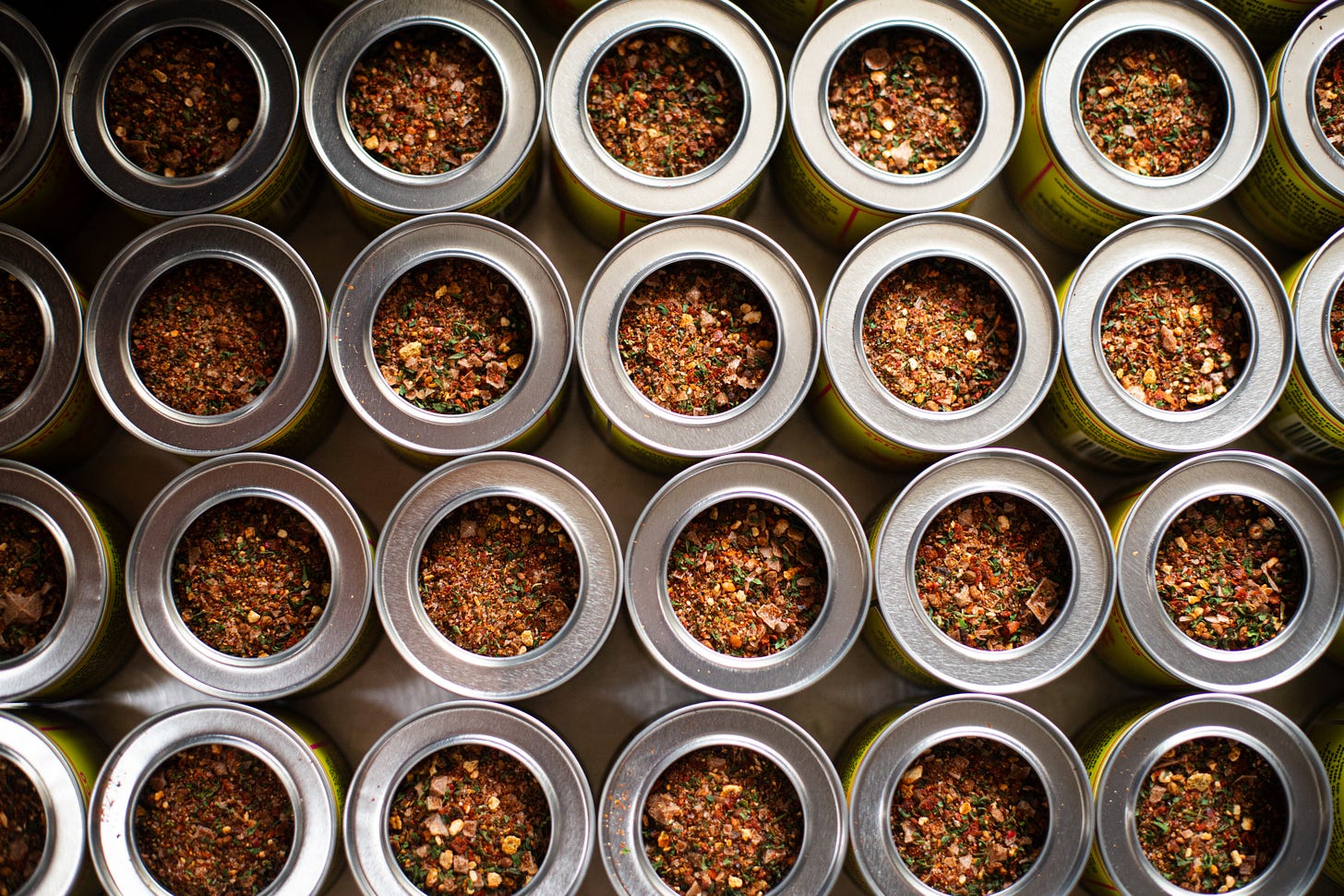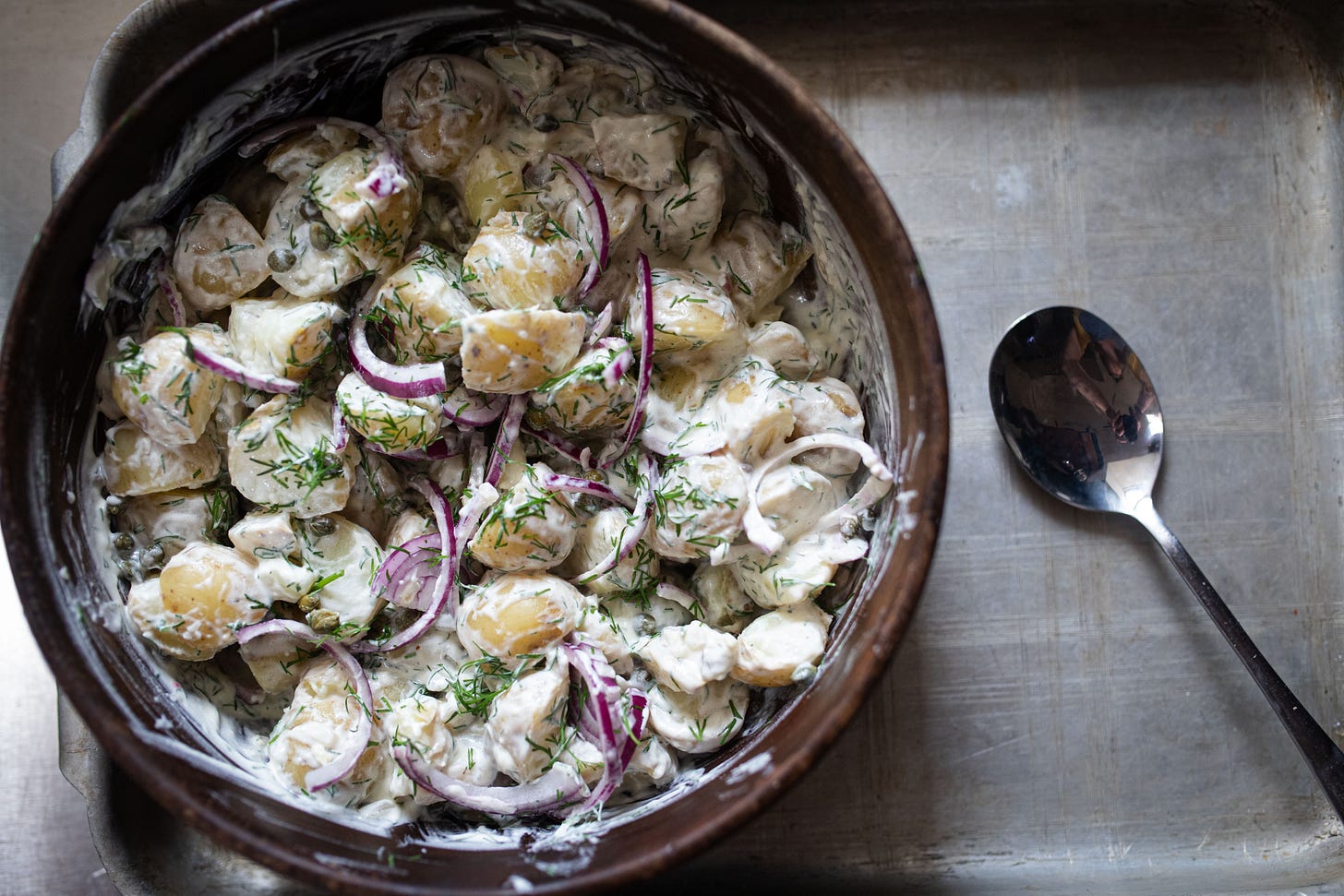The View From the Learning Curve
plus the best potato salad in the history of potato salad.
For the last month Lucy and I have started every day with the three tasks - make a coffee, check our emails and refresh our spice tin supplier website.
At the end of March, we were running low on the tins we use for our spice blends. We logged to make our usual order to discover they were out of stock. Over the next week, we watched as the “back in stock” date got further and further out with every refresh - first a week…then two…then five.
In our ever-growing file of things we didn’t know in February but definitely do now, we’ve learned:
There’s only one other supplier in the UK making food-grade, paint-pot style tins.
Even if your products aren’t made in China, a U.S. trade war with China can still totally derail your supply chain.
You can get custom tins manufactured—but only if you have the cash to order 30,000 of them and wait at least six weeks.
As someone whose self-worth has long been tied to being “good” at things, the constant learning required of running a start up can feel uncomfortably close to failure. I catch myself thinking, If only I’d worked harder. Gotten up earlier. Started this 20 years ago. Studied accountancy. Earned a logistics degree. Then I’d magically understand cash flow forecasting, global supply chain dynamics, and how to build a stock management system and then maybe—just maybe—we wouldn’t have to send quite so many “We’re so sorry, we’re out of stock” emails.
Over the years as my work has shifted and changed, I’ve worn more hats than I can count: accountant, web developer, shipping manager, photographer, social media guru, head gardener, chef, electrician, plumber, compliance officer, and logistics lead—often all in the same day, and usually without a manual beyond good googling skills.
Running your own business takes that certain boldness—a kind of confidence that says, “Sure, I can do that!”
But the learning curve? It is steep enough to make your head spin.
I look around slightly envious of people who know things. I spent 20 years learning how to tell stories with words and images, how to grow and cook food, and how to teach others to do the same. Good for many things, but less useful when managing logistics for a start up.
Everything else, well, I guess we’ll just have to learn it on the job (and get to the point where we can invest more in experts to help us along the way).
And we have a bit more time to do it now—because the spice tins are finally back in stock (and we’ve set up a low-stock alert in our shiny new logistics management software).
Look at us, practically professionals.
A return of spice tins, means a return of Pickle Tickle Pickle Salt, for those of you who are fans. New stock will go live on Wednesday at 9am.
Out and About This Month:
A list of markets, events and places we (mostly Kevin, who loves markets) will be this month.
4th May - Park Lane Market, Glasgow
9th May - Scottish Edge Finals, Edinburgh
10th & 11th May - Bowhouse Food Weekend, Fife
12th May - Stockbridge Market, Edinburgh
24th May - Leith Market, Edinburgh
New Potato and Pickle Potato Salad
The part of my job that I am not quite as terrible at is the seasonal recipe development and this week, I made what can only be described at the best potato salad recipe of my life. A bold claim, but even Theo ate it, so make of that what you will.
You’d think we’d be sick of pickles, but no, this is what pickles are made for. The sharpness of Goat Rodeo Goods’ Rodeo Disco Pickles cuts through the creamy mayo and the capers and red onions just lift this to “eat straight out of the bowl” potato salad.
750g new potatoes, scrubbed clean
50g Rodeo Diso Pickles, finely chopped
1/2 red onion, sliced thinly
1 small bunch fresh dill, chopped (reserve a few sprigs for garnish)
2 tablespoons capers, drained (optional but excellent)
100g mayonnaise (for even more picklyness, use our pickle mayo recipe)
2 tablespoons sour cream or plain Greek yoghurt
1 tablespoon Dijon mustard
1 tablespoon pickle brine (straight from the jar!)
1 tablespoon of lemon juice
½ teaspoon salt
Freshly ground black pepper, to taste
Boil the Potatoes:
Place the new potatoes in a large pot, cover with cold water, and add a generous pinch of salt. Bring to the boil, then reduce to a simmer. Cook for 15–20 minutes, or until just tender when pierced with a knife.
Cool and Cut:
Drain the potatoes and let them cool slightly. While still warm (but manageable), halve or quarter them, depending on size.Mix the Dressing
In a large bowl, whisk together the mayonnaise, sour cream (or yoghurt), Dijon mustard, pickle brine, salt, and pepper until smooth.Assemble the Salad:
Add the warm potatoes to the dressing and toss gently to coat. Fold in the chopped pickles, red onions, capers, and most of the chopped dill.Chill or Serve:
The salad can be served slightly warm, or covered and chilled for at least 30 minutes to allow the flavours to develop.Garnish:
Before serving, sprinkle over the reserved dill and a few extra pickle slices if you like.
Tips:
If you like a bit more punch, I would add a teaspoon of horseradish to the dressing.
Swap the onions for spring onions for a less sharp bite.
Add chopped hard-boiled eggs (American style) for an even heartier salad.



